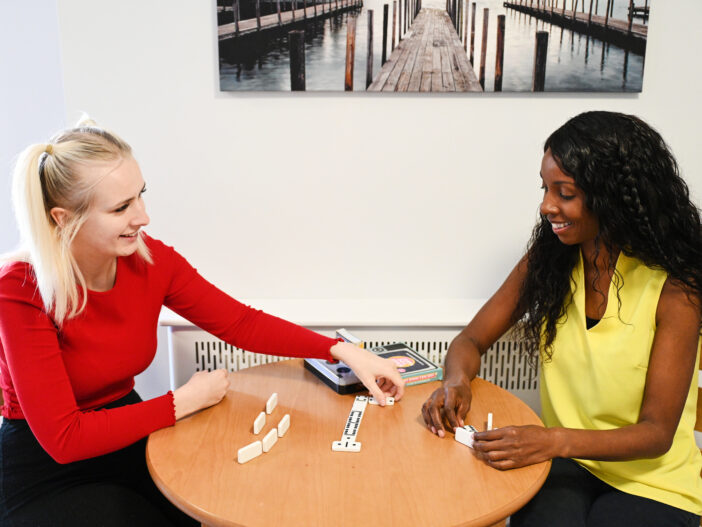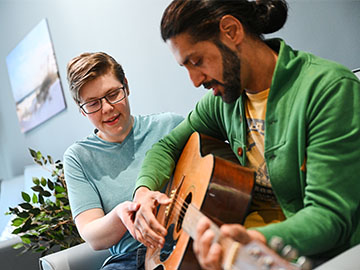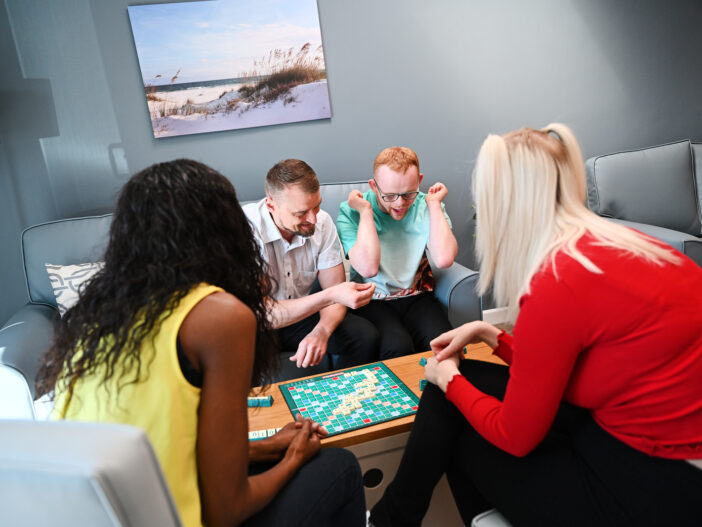Creating accessible environments for autistic people
The environment around us can have a huge impact on how we feel, think and interact. For autistic people, this is especially true. A well-designed space is an essential part of their support, helping to build confidence, reduce stress and improve communication. Creating a safe and comfortable space not only improves overall wellbeing but it can also provide the stability many individuals need to thrive and reach personal goals.
In this blog, we’ll explore why the right environment is such an important factor in supporting autistic people. By making small adjustments, we can create spaces that make everyday life accessible and comfortable for autistic people.
Why is environment important for autistic people?
Many autistic people experience the world in a different way and environmental challenges can make everyday experiences more difficult.
When faced with a challenging environment, autistic individuals may experience physical, social, and sensory difficulties, such as heightened or low levels of stimulation, increased motor challenges and communication struggles.
Environment’s can also impact autistic people’s emotions. An environment that causes high levels of stress and worry, can result in someone struggling to express emotions and feelings. A disconnect from their body’s natural needs can also occur, meaning key signals are missed such as hunger or thirst.
Creating spaces that are tailored to individual preferences can help to reduce stress and support positive behaviour.
How can an environment become accessible for autistic people?
Making environments more accessible involves more than just physical features. It’s important to consider things like sensory sensitivities, emotional wellbeing, and the need for routine and predictability.
Each autistic individual is unique and their needs won’t be the same as others. What works well for one person, might be uncomfortable or overwhelming for another. Making personalised adjustments based on individual preferences is key when creating an autism friendly environment.
It’s important care plans reflect key preferences for each individual to help create an environment they are comfortable in.

Sensory adjustments
Sensory needs play a key role in creating a comfortable environment. Whether at home or out in the community, it’s important to understand an individual’s sensory preferences and be mindful that each autistic person can react differently to certain stimulations.
Some key things to consider might include:
Bright lights – Some people may find harsh lighting distressing. Options like dimmable lights, dark rooms or tools like sunglasses might help.
Crowds – Being surrounded by people and busy spaces can create anxiety. Planning outings during quieter times of the day or finding locations that use fast-tracking systems may ease this.
Noise – Loud or sudden sounds may cause stress and overwhelm. Small adjustments like using paper towels instead of the hand dryer could help or consider the volume of a radio/music at home.
At Southview, one of our specialist autism services, the team created a sensory room with some of these needs in mind. They also transformed a room of the home into a dedicated reading room, ensuring the people we support had a quiet area to go.
Having a range of sensory experiences helps autistic people develop coping mechanisms and feel more comfortable. By introducing sensory tools gradually, individuals can adapt to changes in their environment and develop a sense of control.
One example is how our team at BROCS, one of our specialist autism day services, used musical instruments to stimulate hearing. The music helped bring the people we support together, empowering relationships, while also improving physical development and overall wellbeing.
Structure and Routine
With many autistic people, structure and routine provides a vital sense of stability. This also applies when creating an autism friendly environment. When an environment feels predictable, this can help to reduce anxiety and stress.
This often means thinking ahead and planning in advance. For example, when planning a day trip, individuals might benefit from seeing a map or photos of where they’re going, so they know what to expect on the day. Also highlighting sensory information on the map can reduce triggers by allowing the autistic individual to know where things such as bright lights or loud noises may be located.
We’ve seen first-hand how structure and routine can help autistic individuals thrive in their environment. Jordan, a person we support in supported living, benefited from a consistent routine that contained the things he loves. It helped him gain confidence and independence, taking him on a journey to volunteering work.
The role of visual supports
Visual supports are a powerful tool to promote meaningful engagement for autistic people. They can help build confidence, reduce anxiety, and increase social interaction.
These tools can be helpful throughout an individual’s life, providing support to understand social cues and help navigate everyday interactions with others.

Visual aids can also help autistic individuals feel more comfortable within their environment. Whether at home or in the community, it’s ideal to have these placed in locations that are easy to find, ideally at eye level.
Across our services, we use a range of visual aids and here are a few examples of how they can be used effectively:
- Picture symbols – To explain specific areas of the building, such as food for the kitchen or a shower for the bathroom.
- Small objects – Miniatures of real objects to help someone understand different textures etc.
- Written labels – To help find certain objects or rooms within an environment.
- Coloured cards – To express emotions, such as green for feeling happy, and red for feeling unhappy.
- Visual countdown charts – To help prepare for an event.
Visual aids go a long way in helping autistic people break through barriers. Sarah, a person we support, was struggling to understand when certain events were taking place, leading to increased anxiety. Our team introduced a visual countdown chart with pictures to help Sarah better understand when events were happening. This improved Sarah’s understanding and reduced her anxiety.
Specialist autism support
Creating an autism-friendly environment isn’t about making one big change, it’s about understanding individual needs and making thoughtful adjustments that promote comfort, confidence, and independence.
With the right environment, autistic people can feel more at ease and empowered in their daily lives.
To read more on how we’re supporting autistic people to achieve their goals and live fulfilling lives, head to our stories area.

 Information
Information 

